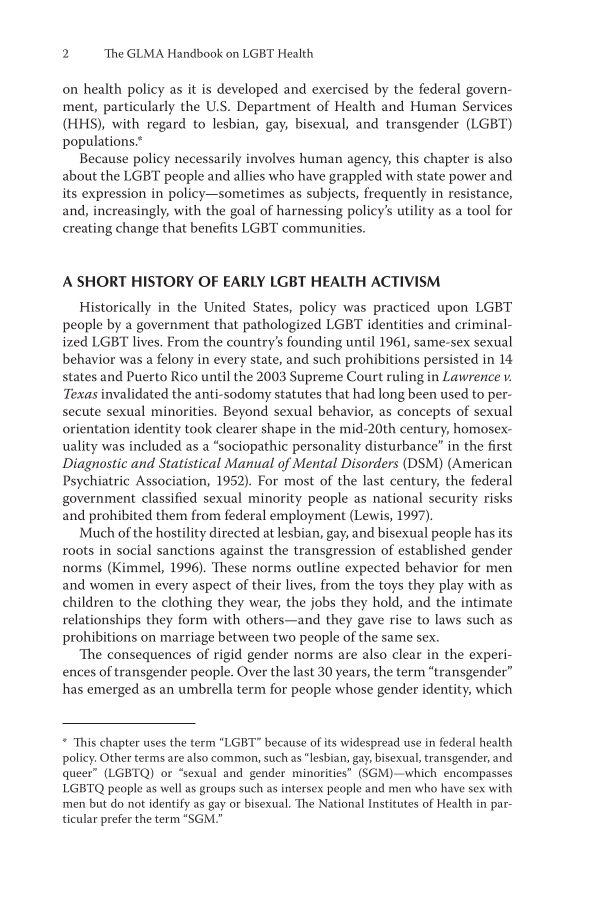2 The GLMA Handbook on LGBT Health on health policy as it is developed and exercised by the federal govern- ment, particularly the U.S. Department of Health and Human Services (HHS), with regard to lesbian, gay, bisexual, and transgender (LGBT) populations.* Because policy necessarily involves human agency, this chapter is also about the LGBT people and allies who have grappled with state power and its expression in policy—sometimes as subjects, frequently in resistance, and, increasingly, with the goal of harnessing policy’s utility as a tool for creating change that benefits LGBT communities. A SHORT HISTORY OF EARLY LGBT HEALTH ACTIVISM Historically in the United States, policy was practiced upon LGBT people by a government that pathologized LGBT identities and criminal- ized LGBT lives. From the country’s founding until 1961, same-sex sexual behavior was a felony in every state, and such prohibitions persisted in 14 states and Puerto Rico until the 2003 Supreme Court ruling in Lawrence v. Texas invalidated the anti-sodomy statutes that had long been used to per- secute sexual minorities. Beyond sexual behavior, as concepts of sexual orientation identity took clearer shape in the mid-20th century, homosex- uality was included as a “sociopathic personality disturbance” in the first Diagnostic and Statistical Manual of Mental Disorders (DSM) (American Psychiatric Association, 1952). For most of the last century, the federal government classified sexual minority people as national security risks and prohibited them from federal employment (Lewis, 1997). Much of the hostility directed at lesbian, gay, and bisexual people has its roots in social sanctions against the transgression of established gender norms (Kimmel, 1996). These norms outline expected behavior for men and women in every aspect of their lives, from the toys they play with as children to the clothing they wear, the jobs they hold, and the intimate relationships they form with others—and they gave rise to laws such as prohibitions on marriage between two people of the same sex. The consequences of rigid gender norms are also clear in the experi- ences of transgender people. Over the last 30 years, the term “transgender” has emerged as an umbrella term for people whose gender identity, which * This chapter uses the term “LGBT” because of its widespread use in federal health policy. Other terms are also common, such as “lesbian, gay, bisexual, transgender, and queer” (LGBTQ) or “sexual and gender minorities” (SGM)—which encompasses LGBTQ people as well as groups such as intersex people and men who have sex with men but do not identify as gay or bisexual. The National Institutes of Health in par- ticular prefer the term “SGM.”
Document Details My Account Print multiple pages
Print
You have printed 0 times in the last 24 hours.
Your print count will reset on at .
You may print 0 more time(s) before then.
You may print a maximum of 0 pages at a time.





























































































































































































































































































































































































































































































































































































































